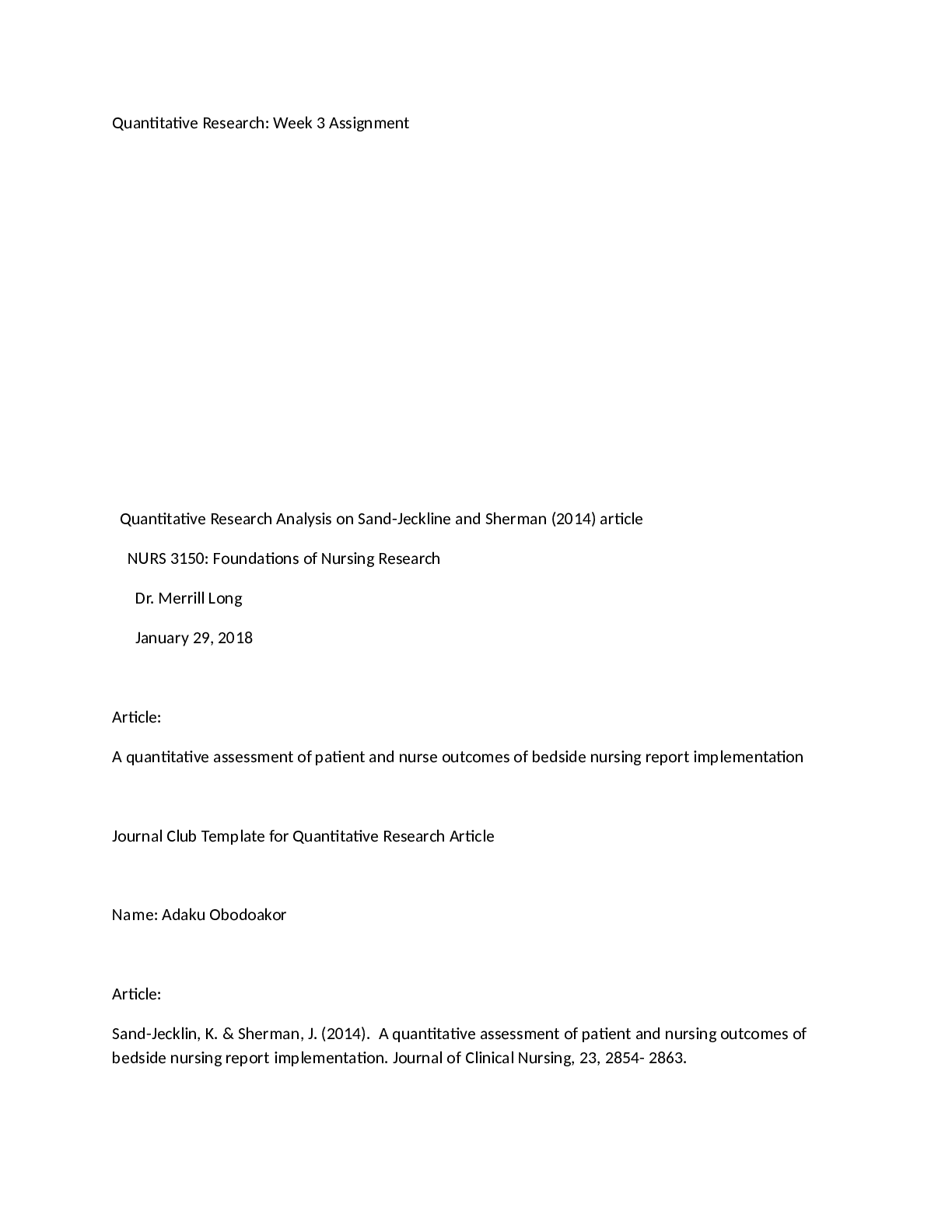Purpose of study: This objective of this research was to obtain a quantitative analysis of patient and
nurse outcome of practice change in reporting for bedside nursing. Past literature had shown benefits of
bedside nursing report but had not quantified the results, and this study aimed to achieve this purpose.
Data collected from seven medical-surgical units in a university hospital which had implemented a
combination of recording and reporting bedside nursing. The data analyzed by checking the related
change in nursing satisfaction, patient satisfaction, patient falls, nursing overtime and medication errors
(Sand-Jecklin & Sherman, 2014).
Research Design
The purpose of the researcher is to identify and gather reports utilizing a quantitative outcome that
indicates a nursing practice change in the bedside nursing report. This study used a research design
called Quasi-Experimental pre- and post-implementation to quantifies the results of bedside reporting.
Quasi-experimental studies in nursing are conducted to determine the effects of nursing interventions or
treatments (independent variables) on patient outcomes (dependent variables), (Grove, Burns, & Gray,
2013, p. 49). Quasi-experimental studies indicate performing of the nursing assessment or practices that
help to check changes in patient falls during the evolution of shift an hour prior and after
implementation of bedside report to determine patient outcomes.
Sample Selection
3.In this research study there is various sample selection collection on the patients/families, and nurses
for pre-implementation and post-implementation in regards to assessing related changes based on the
nursing satisfaction, patient satisfaction, patient falls, nursing overtime, and medication error (Sand-
Jecklin & Sherman, 2014). The first data collection selected from a reference line sample size of 233
patients, then 157 patients data collected, for the three months and 154 patients used at 13months. All
data collection period done during post-implementation.
Also, sample selection performed on the 70 family members as a baseline data collection, 72 samples
selected for three months and 53 for 13 months study which are all done for post-implementation in
preparation for data collection. The research study for nurse satisfaction, the sample used was 148
nurses as a baseline data collection, 98 samples used for three months and 54 executed for the 13
months which are all performed during the post-implementation survey period (Sand-Jecklin & Sherman,
2014).
The study reported by Sand-Jecklin and Sherman (2013) did find significant improvements in patient
information as a result of bedside report using a large sample size of 302 patients/families pre-
implementation and 250 post-implementation.
Data Collection Methods
3. There are several methods used in data collection in this research study which are observation and
questionnaire. The researcher designed questions and displayed it as questionnaire and online
interviews. The surveys used as data collections from patients and families. Then, the researcher group
used the online interviews for the nurses, patients, and families that are not available for questionnaires.
Another data collection method is fall observation where patients observed during falls followed by
medication errors (Sand-Jecklin & Sherman, 2014).
Data Collection Measures/Tools
3. The researcher utilized three tools to measure data collection such as observation, online interviews,
and questionnaires. The nurse behavior data collected from patients answering 17 questions via
Questionnaires. Online interview designed in questionnaires styles that are used by nurses to indicate
the effectiveness of bedside report for both patients and staffs. Observation method was used to
monitor the number of time patients fell out of the bed (Sand-Jecklin & Sherman, 2014). Measurements
of falls done during the shift change and any other falls that happened outside shift change report not
included and measured. For example, based on the report, the amount of patient falls during an end of
shift change reduced from 20 pre-implementation to 13 in three-month post-implementation and finally
4 in 13months post-implementation (Sand-Jecklin & Sherman, 2014). Nursing overtime measured
through employee time records. The work time records are monitored by nine nurses each unit, to
ensure the uniformity or equality of nurses in regards to nurse working experience. The measurement of
overtime minutes done in 10 shifts on each month.
Plans for Data Analysis
3.Data analysis planning is performed with ANOVA tests to check the pre-implementation and post-
implementation patients and nurses data collections to compare the changes between the two for a
detailed explanation of medication errors and patients fall and other variables that might alter the
resulting study. Patients' narrative analysis was performed (Sand-Jecklin & Sherman, 2014). In research
study, analyzing data decreases, identified, arranged and creates meaning to the information analyzed
(Gray, Grove, & Sutherland, 2017). This study identified and explained each data collected from various
people show bedside reporting that includes patients, family and nurses/staffs performance in avoiding
many errors in nursing care practices from happening.
Read More


